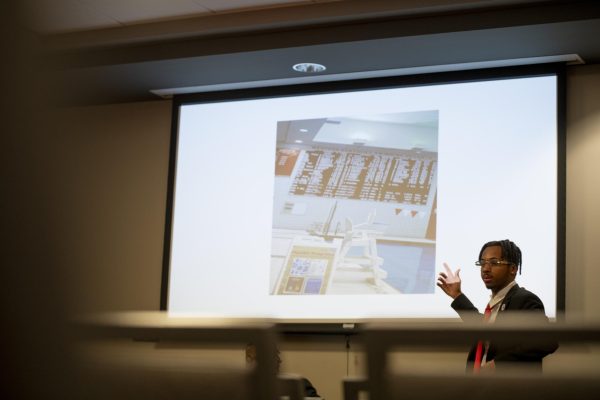Laptop life
January 30, 2003
Blue screens glow from every direction. They are in the food court, in the Valley lawn, even outside Cherry Hall. And the clicking echoes down the hill.
No pens and paper are required in this new learning environment. This is a university where every student has a laptop and the latest technology at their fingertips.
This is the vision of the laptop university committee.
Their vision begins with a pilot program.
Western is considering a pilot program for a laptop university where every student has a laptop or Personal Digital Assistant and where there are enough resources available to help students succeed in an information-based world, said Richard Kirchmeyer, vice president of Information Technologies.
The committee wants students to have access to the Internet anywhere on campus through wireless Internet service. It wants professors to utilize online discussions. It wants companies to be impressed by Western graduates’s ability to use technology with ease.
“While laptop use will change the classroom, the concept is probably much more important in fostering change in the university as a whole,” said Rob Wyatt, biology professor and committee member. “This could occur by extending learning outside the classroom and allowing the students to participate more fully in a total learning environment.”
Formatting the Hill
But before this vision becomes a reality, Western has to beef up the infrastructure to determine if a laptop university will work and if people will use it.
Classrooms must be technologically equipped to handle the load of 30 laptops working at the same time.
Participating departments in the pilot program will access and choose the best equipment for their needs.
Faculty will receive laptops a year before students in order to begin planning and training on the new machines.
The committee wants “laptop bars” built into lobbies and commons areas to make power outlets and Internet access readily available.
“It would be a recipe for failure to implement a laptop university pilot before you do the infrastructure,” Kirchmeyer said.
Western is in the process of upgrading the current network to a faster system and working to expand its connection to the external Internet, Kirchmeyer said. Every building on campus will soon be equipped with a one gigabite Internet connection.
“The way students will feel it immediately is in response time, and their ability to get consistently fast and reliable access will increase,” said Gordon Johnson, administrative computing services director.
Booting up
The cost of implementing the laptop university pilot program will not be cheap. Estimated costs total about $1.18 million, according to committee documents.
In the proposed pilot program, students will pay Western approximately $380 to $480 per semester for a laptop. The estimated cost for a PDA is $250 to $300 for two semesters.
There will be one computer provider, which has yet to be decided, supplying PC compatible laptops to students. Students will receive new laptops at the beginning of their freshman and junior years. After graduation, they’ll have the option to buy them.
Software will be provided by Western, and certain departments may require other programs, which will also be available to students. Students could buy ink jet printers through Western as well.
“The biggest change would be how students learn,” Kirchmeyer said. “Now, they can learn from any place on campus. Instead of being in their classroom, they can learn anyplace — either indoors or outdoors, while they’re eating, between classes; they can stop any place on campus and see what’s going on in their next class.”
Networking
Western has been watching other universities to get ideas on creating its own laptop university pilot program. Valley City State University in North Dakota implemented a laptop university in 1996.
VCSU students pay $499 a semester for their laptop, plus $100 to keep it over the summer. Students aren’t given a choice; they must participate in the laptop university.
“I’m an example of teaching an old dog new tricks,” said Kay Kringlie, Spanish and English professor at VCSU. “But I’d never want to go back or leave this environment. Our students come in and just plug in their laptops. It’s great.”
Kringlie once taught her classes via the Internet from Mexico.
“The beauty of this is that they can access it anywhere and look at the videos I’m posting,” she said.
Bells and Whistles
Western’s new laptops wouldn’t just be something else for students to lug up the Hill. They could help put more cash in students’s pockets.
Trained students will be paid to help faculty in the classroom and run a 24-hour help desk. Dorms may also be staffed with student technology aids.
“Laptop universities have students who have high educational productivity and a close familiarity with technology,” Bowling Green senior and committee member Sam Stinson said.
Other laptop university schools, such as VCSU, have experienced a higher demand for their graduates.
“Employers will love students who have been personally responsible and used laptops for the last four years,” Kirchmeyer said. “They’ll know how to use the computer for more than term papers, e-mail and the Internet. They are familiar with collaboration techniques, with creative software. They are just so much more marketable.”
Ready to upgrade
Couches could become the new desk of choice if the laptop university is implemented. This is an idea that has Owensboro freshman Patrick Mulligan excited.
“It would help keep track of papers, and it would just be nice to be able to write a paper wherever you want — in the library or coffee shop or wherever,” he said.
The committee must wait for funding and approval before moving on with the program.
“We’re not saying it’s going to work, but we put the best thoughts into it to see if it could work,” said Blaine Ferrell, dean of Ogden College of Science and Engineering. “Some schools have been extremely successful with it and love it.”
Reach Jessica Sasseen at [email protected].
























